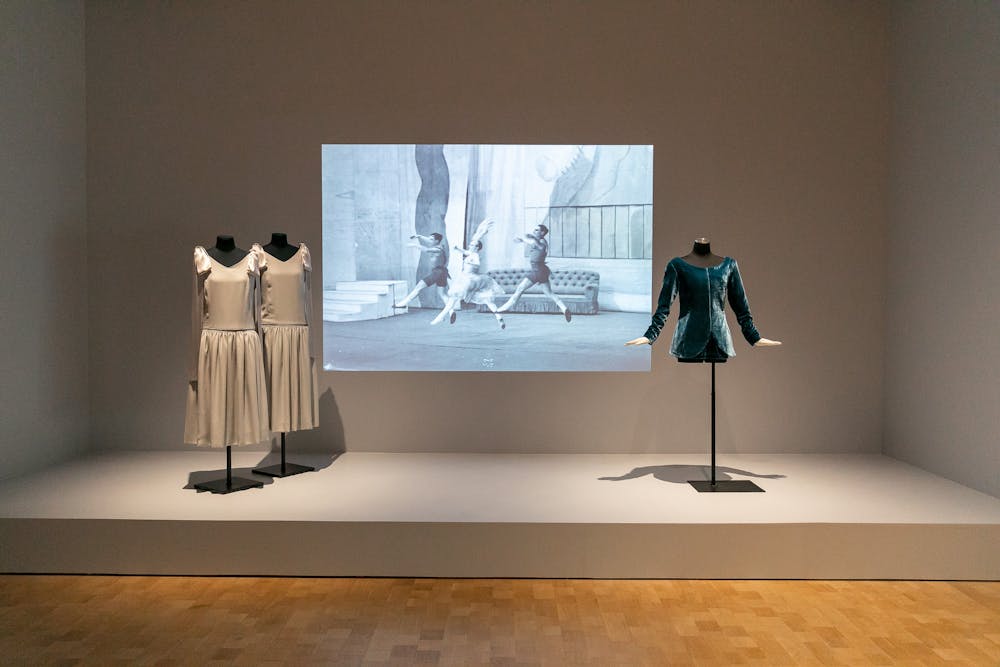“I feel perfectly at ease with everything feminine,” Marie Laurencin wrote in her Le Carnet des Nuits. “When I was small I loved silk threads, and I stole pearls and spools of colored thread which I hid carefully and would look at when I was alone. I would have liked to have had many children to comb their hair and dress with ribbons.”
For Laurencin, her ease with everything feminine is at the center of the Barnes Foundation’s latest exhibit, Marie Laurencin: Sapphic Paris, which is on view until Jan. 21. The show is the first major exhibit of Laurencin’s work in over three decades, and it’s the first to highlight one thing: that her feminine work is unequivocally sapphic and queer, and the worlds she creates in each painting are importantly lacking in men.
As a friend to Georges Braque, Francis Picabia, and Pablo Picasso, Laurencin was at the center of the Parisian, male–dominated Cubist and avant–garde art scene in the early 20th century. Her work was definitively modern through her involvement in this movement, especially in her early works, but crucially, it was modern because of its content. While using select formal elements of Cubism, Laurencin created almost futuristic pastel worlds where in nearly all her paintings men, put simply, did not exist.
Her works hanging at the Barnes prove this point. In The Visit, a woman in a blue dress on a white horse rides up to two other women standing behind the bars of a balcony. It’s as if Prince–no, Princess–Charming rides up to Rapunzel on her tower.

Marie Laurencin. The Visit (La visite), 1916. The Metropolitan Museum of Art, New York. Bequest of Scofield Thayer, 1982. Artwork © Fondation Foujita / Artists Rights Society (ARS), New York / ADAGP, Paris 2023.
In Women in the Forest, Laurencin reinterprets fête galante—a genre associated with French artist Jean–Antoine Watteau, who crafted courtship scenes of elegant men and women in gardens. Laurencin’s version (you guessed it) is wholly devoid of men. Does (in French, “doe” is slang for lesbian) intertwine with and complement the flirtatious, pale gray women.

Marie Laurencin. Women in the Forest (Femmes dans la forêt), 1920. Private collection, Alberta, Canada. Artwork © Fondation Foujita / Artists Rights Society (ARS), New York / ADAGP, Paris 2023.
And it’s not just her paintings that espouse sapphic femininity. The exhibit features Laurencin's costume and set designs for the ballet Les Biches, which translates to The Does, anchoring this motif throughout her work. Laurencin's designs allowed her to bring to life her ephemeral, feminine vision. So do her drawings—the gallery boasts illustrations for a translation of Sappho’s poems, explicitly emphasizing Laurencin’s queer identity.
In the last room of the exhibit hang Laurencin's portraits of influential women. There’s the representation of perhaps the most recognized woman in fashion, Coco Chanel, in Laurencin’s Portrait of Mademoiselle Chanel. There’s also the Portrait of Helena Rubinstein, one of the world's richest women during her lifetime and founder of Helena Rubinstein Inc. (now part of L’Òreal). As a powerful force of a woman, Laurencin painted her powerful female contemporaries.
Although her work is coded in consideration of the times she lived in—there are no explicit drawings of romantic relationships between women—the Barnes makes it clear that the art historical canon cannot ignore Laurencin as a powerful figure in queer art history. The exhibition design plays to her vision of a wholly feminine world—the gallery walls are painted pastel pinks, purples, and greens, playing off of her own color palette. The exhibition's entrance also boasts a faux balcony, allowing visitors to pose as if they are in a Laurencin painting. The whole gallery makes the case for art without men, even alongside the Barnes’s permanent collection, which is heavily dominated by male artists.
Step into Marie Laurencin: Sapphic Paris, and you’ve stepped into one of her paintings—into her world without men. Laurencin was far before her time—she addresses themes that today, the Barbie movie, the Guerrilla Girls, and modern scholars aspire to do. Despite being born in 1883, her placing of sapphic women at the center of modern art is still modern—and revolutionary.







